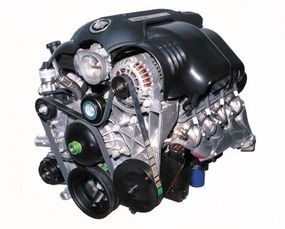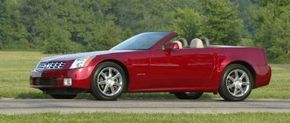New dreams of the racetrack, following a short-lived late-'90s assault on the yearly LeMans 24-Hour grind, prompted Cadillac to work up a hot CTS-V as both road-burner and hoped-for competition star. An early 2004 arrival, it was the first in a planned series of high-performance V-models that would be to Cadillac what the M Division was to BMW and AMG to Mercedes.
Cadillacs had usually offered good speed, but only in a straight line. Not this time. To the already capable CTS chassis, engineers at GM's new Performance Division added heavier-gauge steel suspension cradles, thicker front and rear stabilizer bars, high-rate shocks, and a crossbrace atop the front-suspension towers to bolster rigidity.
Some steel suspension pieces were swapped for lighter aluminum components, but the basic geometry was unchanged. Other upgrades included a massive four-piston Brembo-brand disc brake at each corner and meaty 245/45ZR18 Goodyear run-flat tires on special seven-spoke alloy wheels spreading 8.5 inches wide.
But the most exciting upgrade was underhood, where Cadillac found room for the 5.7-liter (346-cid) LS6 V-8 from the contemporary C5-generation Corvette Z06. The transplant cost a little power, but not much, with rated outputs of 400 bhp at a zingy 6000 rpm and 395 beefy pound-feet of torque peaking at 4800.
The result was the most potent production Cadillac ever, proof that the division was dead serious about cracking the enthusiast market. More proof came with a mandatory six-speed manual transmission, the same Tremec T56 unit used in the 'Vette, but relocated from the rear to just behind the engine. Cadillac hardly missed a trick, specifying a heavier-than-stock driveshaft, a limited-slip rear differential with strong but light cast-aluminum housing, and fairly tight gearing (3.73:1).
For a factory hot rod, the CTS-V was visually restrained. Add-ons were limited to more-aggressive lower fascias front and rear, a distinctive wire-mesh grille insert, subtle "aero" rocker panel skirts, and telltale dual exhausts. Inside were satin-chrome-finish trim instead of the usual wood, plus bright-ringed gauges and, for exuberant cornering, grippy suede seat inserts. Even the central armrest was lowered some four inches to ease shifting.
Here it seemed was a Cadillac that really could go wheel-to-wheel with Europe's best sports sedans, and "car buff" magazines wasted no time arranging showdown tests. Car and Driver first pitted the CTS-V against a BMW M3 coupe and new M5 sedan, judging the Cadillac equal or better in most respects, especially for value.
The CTS-V wasn't cheap at an initial $49,300 base, but the M5 cost a whopping $23,000 more. Later, Car and Driver judged the CTS-V a close second to the Audi S4 quattro and ahead of Mercedes' C55 AMG in a three-way matchup. "[W]e emerged with a unanimous sense of the CTS-V as the road-course champ," said the editors. Yet they found straightline go no less impressive, clocking just 4.8 seconds 0-60 mph and a standing quarter-mile of 13.2 seconds at 109 mph.
Stats like that implied race-winning potential, and Cadillac wanted the positive press that goes with winning races.
Accordingly, the division backed a two-car CTS-V team for the 2004 season of the Sports Car Club of America's Speed World Challenge series for production-based cars. Against the formidable likes of modified Corvettes, Dodge Vipers, and Porsche 911s, the Cadillac tallied four pole starts and three wins -- not bad for a beginner.
Cadillac built 2401 CTS-Vs for 2004. Another 4194 issued forth for '05, when the only changes were monetary: a $190 bump in starting price (there were still no options) and a tacked-on $1300 Gas-Guzzler Tax. The '06 version nominally broke the $50,000 barrier, but some of the increase reflected swapping in the 6.0-liter LS2 V-8 from the year-old C6-generation Corvette. Interestingly, the bigger engine was claimed to have no more power or torque than the 5.7, though it most surely did.
For those who craved the V-Series' looks but didn't need its testosterone, a Wheel Sport Appearance package arrived during the '06 model year to dress up the mainstream 3.6 CTS, one of the few alterations that season.
A new high-performance two-seat Caddy convertible was also on tap for 2004.














